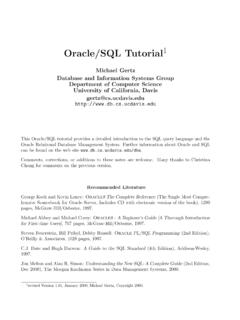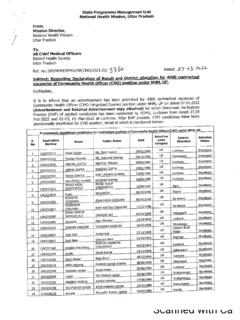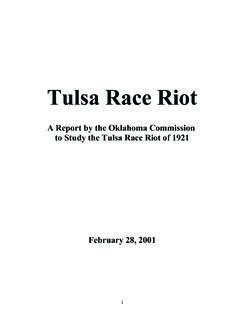Transcription of Air Pollution Control Technology Fact Sheet
1 EPA-452/F-03-032 Air Pollution Control Technology Fact SheetEPA-CICA Fact SheetSCR1 Name of Technology : Selective Catalytic Reduction (SCR) Type of Technology : Control Device - Chemical reduction via a reducing agent and a Pollutants: Nitrogen Oxides (NOx)Achievable Emission Limits/Reductions: SCR is capable of NOx reduction efficiencies in the range of70% to 90% (ICAC, 2000). Higher reductions are possible but generally are not Source Type: PointTypical Industrial Applications: Stationary fossil fuel combustion units such as electrical utility boilers,industrial boilers, process heaters, gas turbines, and reciprocating internal combustion engines. In addition,SCR has been applied to nitric acid plants. (ICAC, 1997 )Emission Stream Characteristics: Unit Size: In the United States, SCR has been applied to coal- and natural gas-fired electrical utility boilers ranging in size from 250 to 8,000 MMBtu/hr (25 to 800 MW) (EPA,2002). SCR can be cost effective for large industrial boilers and process heaters operating at highto moderate capacity factors (>100 MMBtu/hr or >10MW for coal-fired and >50 MMBtu/hr or>5MW for gas-fired boilers).
2 SCR is a widely used Technology for large gas Temperature: The NOx reduction reaction is effective only within a given temperature range. Theoptimum temperature range depends on the type of catalyst used and the flue gas temperatures vary from 480 F to 800 F (250 C to 427 C) (ICAC, 1997 ). Typical SCRsystems tolerate temperature fluctuations of 200 F ( 90 C) (EPA, 2002).c. Pollutant Loading: SCR can achieve high reduction efficiencies (>70%) on NOx concentrationsas low as 20 parts per million (ppm). Higher NOx levels result in increased performance; however,above 150 ppm, the reaction rate does not increase significantly (Environex, 2000). High levelsof sulfur and particulate matter (PM) in the waste gas stream will increase the cost of SCR. Considerations: Ammonia slip refers to emissions of unreacted ammonia that result fromincomplete reaction of the NOx and the reagent. Ammonia slip may cause: 1) formation ofammonium sulfates, which can plug or corrode downstream components, and 2) ammoniaabsorption into fly ash, which may affect disposal or reuse of the ash.
3 In the , permittedammonia slip levels are typically 2 to 10 ppm. Ammonia slip at this levels do not result in plumeformation or human health hazards. Process optimization after installation can lower slip gas streams with high levels of PM may require a sootblower. Sootblowers are installed inthe SCR reactor to reduce deposition of particulate onto the catalyst. It also reduces fouling ofdownstream equipment by ammonium Fact SheetSCR2 The pressure of the waste gas decreases significantly as it flows across the catalyst. Applicationof SCR generally requires installation a new or upgraded induced draft fan to recover Stream Pretreatment Requirements: The flue gas may require heating to raise the temperatureto the optimum range for the reduction reaction. Sulfur and PM may be removed from the waste gas streamto reduce catalyst deactivation and fouling of downstream equipment. Cost Information: Capital costs are significantly higher than other types of NOx controls due to the large volume of catalyst thatis required.
4 The cost of catalyst is approximately 10,000 $/m3 (283 $/ft3). A 350 MMBtu/hr natural gas-firedboiler operating at 85% capacity requires approximately 17 m3 ( 600 ft3). For the same sized coal-fired boiler,the required catalyst is on the order of 42 m3 (1,500 ft3). (NESCAUM 2000).SCR is a proprietary Technology and designs on large combustion units are site specific. Retrofit of SCRon an existing unit can increase costs by over 30% (EPA, 2002). The increase in cost is primarily due toductwork modification, the cost of structural steel, and reactor construction. Significant demolition andrelocation of equipment may be required to provide space for the reactor. The O&M costs of using SCR are driven by the reagent usage, catalyst replacement, and increased electricalpower usage. SCR applications on large units (>100 MMBtu/hr) generally require 20,000 to 100,000 gallonsof reagent per week (EPA, 2002). The catalyst operating life is on the order of 25,000 hours for coal-firedunits and 40,000 hours for oil- and gas-fired units (EPA, 2002).
5 A catalyst management plan can bedeveloped so that only a fraction of the total catalyst inventory, rather than the entire volume, is replaced atany one time. This distributes the catalyst replacement and disposal costs more evenly over the lifetime ofthe system. O&M costs are greatly impacted by the capacity factor of the unit and annual versus seasonalcontrol of cost and the cost per ton of pollutant removed is greatly impacted by the capacity factor andwhether SCR is utilized seasonally or year 1a: Summary of Cost Information in $/MMBtu/hr (1999 Dollars) a, bUnit TypeCapital CostO&M Cost dAnnual Cost dCost per Ton ofPollutant Removed ($/MMBtu)($/MMBtu)($/MMBtu)($/ton)Indust rial Coal Boiler10,000 - 15,0003001,6002,000 - 5,000 Industrial Oil, Gas, Wood c4,000 - 6,0004507001,000 - 3,000 Large Gas Turbine5,000 - 7,5003,5008,5003,000 - 6,000 Small Gas Turbine17,000 - 35,0001,5003,0002,000 - 10,000 EPA-CICA Fact SheetSCR3 Table 1b: Summary of Cost Information in $/MW (1999 Dollars) a, bCapital CostO&M Cost dAnnual Cost d Cost per Ton ofPollutant Removed Unit Type($/MW)($/MW)($/MW)($/ton)Industrial Coal Boiler1,000 - 1,500301602,000 - 5,000 Industrial Oil, Gas, Wood c400 - 60045701,000 - 3,000 Large Gas Turbine500 - 7503508503,000 - 6,000 Small Gas Turbine1,700- 3,5001503002,000 - 10,000a (ICAC, 1997 ; NESCAUM, 2000; EPA, 2002) b Assumes 85% capacity factor and annual Control of NOx c SCR installed on wood fired boiler assumes a hot side electrostatic precipitator for PM removald Coal and oil O&M and annual costs are based on 350 MMBtu boiler, and gas turbine O&M and annual costs are based on 75 MW and 5 MW turbineTheory of Operation:The SCR process chemically reduces the NOx molecule into molecular nitrogen and water vapor.
6 A nitrogenbased reagent such as ammonia or urea is injected into the ductwork, downstream of the combustion waste gas mixes with the reagent and enters a reactor module containing catalyst. The hot flue gas andreagent diffuse through the catalyst. The reagent reacts selectively with the NOx within a specifictemperature range and in the presence of the catalyst and , the amount of reducing agent, injection grid design and catalyst activity are the main factorsthat determine the actual removal efficiency. The use of a catalyst results in two primary advantages of theSCR process over the SNCR: higher NOx Control efficiency and reactions within a lower and broadertemperature range. The benefits are accompanied by a significant increase in capital and operating catalyst is composed of active metals or ceramics with a highly porous structure. Catalysts configurationsare generally ceramic honeycomb and pleated metal plate (monolith) designs.
7 The catalyst composition, type,and physical properties affect performance, reliability, catalyst quantity required, and cost. The SCR systemsupplier and catalyst supplier generally guarantee the catalyst life and performance. Newer catalyst designsincrease catalyst activity, surface area per unit volume, and the temperature range for the reduction activity is a measure of the NOx reduction reaction rate. Catalyst activity is a function of manyvariables including catalyst composition and structure, diffusion rates, mass transfer rates, gas temperature,and gas composition. Catalyst deactivation is caused by: poisoning of active sites by flue gas constituents, thermal sintering of active sites due to high temperatures within reactor, blinding/plugging/fouling of active sites by ammonia-sulfur salts and particulate matter, and erosion due to high gas the catalyst activity decreases, NOx removal decreases and ammonia slip increases.
8 When the ammoniaslip reaches the maximum design or permitted level, new catalyst must be installed. There are severaldifferent locations downstream of the combustion unit where SCR systems can be installed. Most coal-firedapplications locate the reactor downstream of the economizer and upstream of the air heater and particulatecontrol devices (hot-side). The flue gas in this location is usually within the optimum temperature window forNOx reduction reactions using metal oxide catalysts. SCR may be applied after PM and sulfur removalEPA-CICA Fact SheetSCR4equipment (cold-side), however, reheating of the flue gas may be required, which significantly increases theoperational costs. SCR is very cost-effective for natural gas fired units. Less catalyst is required since the waste gas streamhas lower levels of NOx, sulfur, and PM. Combined-cycle natural gas turbines frequently use SCRtechnology for NOx reduction. A typical combined-cycle SCR design places the reactor chamber after thesuperheater within a cavity of the heat recovery steam generator system (HRSG).
9 The flue gas temperaturein this area is within the operating range for base metal-type can be used separately or in combination with other NOx combustion Control technologies such as lowNOx burners (LNB) and natural gas reburn (NGR). SCR can be designed to provide NOx reductions year-round or only during ozone season. Advantages: Higher NOx reductions than low-NOx burners and Selective Non-Catalytic Reduction (SNCR) Applicable to sources with low NOx concentrations Reactions occur within a lower and broader temperature range than SNCR. Does not require modifications to the combustion unitDisadvantages: Significantly higher capital and operating costs than low-NOx burners and SNCR Retrofit of SCR on industrial boilers is difficult and costly Large volume of reagent and catalyst required. May require downstream equipment cleaning. Results in ammonia in the waste gas stream which may impact plume visibility, and resale ordisposal of :EPA, 1998. Environmental Protection Agency, Innovative Strategies and Economics Group, OzoneTransport Rulemaking Non-Electricity Generating Unit Cost Analysis , Prepared by Pechan-Avanti Group,Research Triangle Park, NC.
10 1998. EPA, 1999. US Environmental Protection Agency, Clean Air Technology Center. Technical Bulletin:Nitrogen Oxides (NOx), Why and How They Are Controlled . Research Triangle Park, NC. , 2002. Environmental Protection Agency, Office of Air Quality Planning and Standards. EPA AirPollution Control Cost Manual Section 4 Chapter 2. EPA 452/B-02-001. , 2000. Gaikwad, Kurtides, and DePriest. Optimizing SCR Reactor Design for Future OperatingFlexibility . Presented at the Institute of Clean Air Companies Forum 2000. Washington , 1997 . Institute of Clean Air Companies, Inc. White Paper: Selective Catalytic Reduction (SCR) Control of NOx Emissions . Washington, , 2000. Institute of Clean Air Companies. Optimizing SCR Reactor Design for Future OperatingFlexibility . Washington, Fact SheetSCR5 NESCAUM, 2002. Northeast States for Coordinated Air Use Management. Status Reports on NOxControls for Gas Turbines, Cement Kilns, Industrial Boilers, and Internal Combustion Engines:Technologies & Cost Effectiveness.















